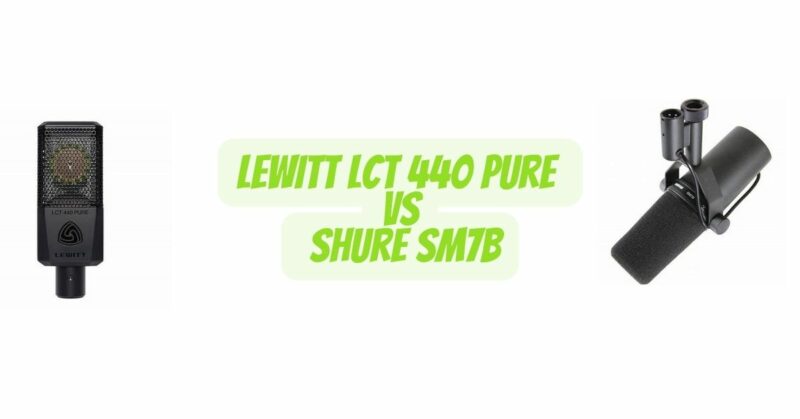When it comes to professional-grade microphones, the Lewitt LCT 440 Pure and the Shure SM7B are two popular choices among recording enthusiasts, podcasters, and broadcasters. Both microphones offer exceptional audio quality and are designed to capture pristine sound in various recording scenarios. In this article, we will compare the Lewitt LCT 440 Pure and the Shure SM7B across different aspects such as design, sound quality, features, and overall performance to help you make an informed decision when choosing between these two options.
Design and Build Quality: The Lewitt LCT 440 Pure and the Shure SM7B exhibit different design aesthetics and build qualities, catering to different user preferences.
The Lewitt LCT 440 Pure features a sleek and modern design with a compact body. It is constructed with high-quality materials that ensure durability and longevity. The microphone includes a shock mount that effectively isolates it from vibrations and handling noise. Additionally, it comes with a windscreen to reduce plosive sounds and a magnetic pop filter for enhanced recording clarity.
In contrast, the Shure SM7B has a more robust and substantial build, designed to withstand professional use. It features a rugged metal construction with internal shock isolation that minimizes mechanical noise and vibrations. The SM7B comes with a built-in yoke mount that allows for easy microphone positioning. It also includes a detachable windscreen and a foam pop filter to further reduce unwanted noise.
Sound Quality and Performance: Both the Lewitt LCT 440 Pure and the Shure SM7B are known for their outstanding sound quality, delivering professional-grade audio reproduction.
The Lewitt LCT 440 Pure utilizes a high-quality, large-diaphragm condenser capsule that captures detailed and transparent sound. It has a flat frequency response, providing accurate and uncolored recordings. The microphone offers three switchable polar patterns (cardioid, omnidirectional, and figure-8) to adapt to different recording scenarios. It also has a high dynamic range, allowing it to handle loud sound sources without distortion.
The Shure SM7B, on the other hand, is a dynamic microphone renowned for its warm and smooth sound signature. It features a flat, wide-range frequency response with excellent off-axis rejection. The SM7B is particularly known for its ability to capture vocals with clarity and depth. It also includes a presence boost switch and bass roll-off switch, giving users additional control over the sound. Moreover, the SM7B has a high output level, making it suitable for recording quiet sources without the need for additional gain.
Features and Flexibility: The Lewitt LCT 440 Pure and the Shure SM7B offer different features and flexibility to accommodate various recording needs.
The Lewitt LCT 440 Pure includes a low-cut filter switch that reduces low-frequency rumble and handling noise. It also provides a pre-attenuation pad switch to handle high sound pressure levels. The microphone requires phantom power to operate and offers a wide frequency response range, ensuring accurate sound reproduction across different applications.
In comparison, the Shure SM7B does not require phantom power, making it a versatile option for those who do not have an audio interface or mixer that provides phantom power. It features a bass roll-off switch that helps control proximity effect and minimize low-frequency rumble. The presence boost switch enhances the clarity and presence of vocals. Additionally, the SM7B has an integrated shock mount and pop filter to further reduce unwanted noise.
Price and Value: When considering the Lewitt LCT 440 Pure and the Shure SM7B, price is an important factor to consider.
The Lewitt LCT 440 Pure is generally more affordable compared to the Shure SM7B. It offers exceptional sound quality and a versatile feature set at a relatively lower price point, making it an attractive option for those on a budget or starting their recording journey.
The Shure SM7B, on the other hand, is priced at a higher range, positioning itself as a professional-grade microphone. It offers exceptional sound quality, robust build quality, and additional features, making it a preferred choice among experienced professionals and professional studios.
Conclusion: Both the Lewitt LCT 440 Pure and the Shure SM7B are highly regarded microphones in the recording industry. The Lewitt LCT 440 Pure excels in its compact design, transparent sound reproduction, and affordability, making it suitable for a wide range of recording applications. The Shure SM7B stands out with its robust build quality, warm and smooth sound signature, and additional features, catering to professional users who prioritize durability and versatility.
When choosing between the Lewitt LCT 440 Pure and the Shure SM7B, consider factors such as your budget, desired sound characteristics, intended use, and any specific features that may be important to your recording setup. Ultimately, the decision should be based on your individual needs and preferences to ensure the microphone you choose aligns with your recording goals.

